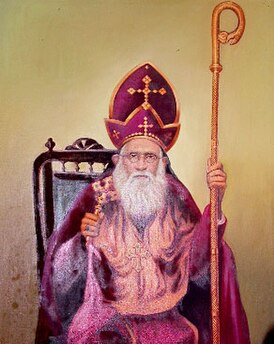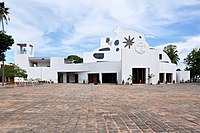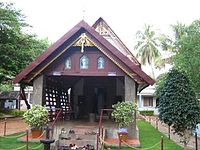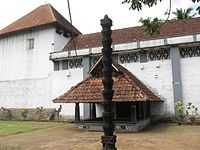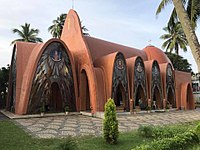Malankara Orthodox Syrian Church
This articleneeds additional citations forverification.(June 2019) |
| Malankara Orthodox
Syrian Church (Indian Orthodox Church) | |
|---|---|
 MOSC Catholicate Palace | |
| Classification | Oriental Orthodox |
| Orientation | Eastern Christianity |
| Scripture | Peshitta |
| Theology | Miaphysitism |
| Polity | Episcopal |
| Governance | Episcopal Synod |
| Primate | Malankara Metropolitan & Catholicos of EastBaselios Marthoma Mathews III |
| Region | Indiaand theNasraniMalayalidiaspora |
| Language | Syriac,Konkani,Malayalam,English |
| Liturgy | West Syriac Rite(Malankara Rite) |
| Headquarters | Catholicate Palace,Kottayam,Kerala,India |
| Founder | Thomas the Apostleby tradition Dionysius VI[1]andBaselios Paulose I(catholicate)[2]: 285 [3] |
| Origin | 1st century by tradition,[4] 1912 |
| Independence | 1912 (Establishment of Catholicate)[5] |
| Separated from | Syriac Orthodox Church[6]: 197 |
| Branched from | Saint Thomas Christians,Malankara Church |
| Separations | Syro-Malankara Catholic Church(1930)[6]: 197 |
| Members | 0.5 million in Kerala[7] |
| Other name(s) | മലങ്കര സഭ (Malankara Church) Indian Orthodox Church |
| Official website | mosc.in |
| Part ofa serieson |
| Oriental Orthodoxy |
|---|
 |
| Oriental Orthodox churches |
|
|
| Part ofa serieson |
| Christianity in India |
|---|
 |
TheMalankara Orthodox Syrian Church(MOSC)[8]also known as theIndian Orthodox Church(IOC)[9]or simply as theMalankara Church,[10]is anautocephalous[11][12][5]Oriental Orthodox churchheadquartered inDevalokam,nearKottayam,India.It serves India'sSaint Thomas Christian(also known asNasrani) population. According to tradition, these communities originated in the missions ofThomas the Apostlein the 1st century (circa 52 AD).[13]It employs theMalankara Rite,an Indian form of theWest Syriacliturgical rite.
The MOSC descends from theMalankara Churchand its affiliation with theSyriac Orthodox Church.However, between 1909 and 1912, aschismover the authority of theSyriac Orthodox Patriarch of Antioch's authority resulted in the dissolution of the unified Malankara Church and establishment of the overlapping and conflicting MOSC andJacobite Syrian Christian Church(JSCC).[3]Since 1912, the MOSC has maintained acatholicate,theCatholicos of the East and Malankara Metropolitan–presentlyBaselios Marthoma Mathews III–who is the primate of the church. The MOSC drafted and formally adopted a constitution in 1934, in order to define the relationship it has with the Syriac Orthodox Church and the patriarch, wherein it defined itself a division of the Syriac Orthodox Church with its supreme spiritual leader being the Patriarch of Antioch. However the constitution stipulated that all the spiritual duties of the patriarch in the Malankara Church was entrusted to the Catholicos of the East and reiterated that its administration was the prerogative of the Malankara Metropolitan. The constitution further declared that the positions of the Catholicos of the East and Malankara Metropolitan are to be held by the same person from then on, who shall henceforth act as the spiritual and administrative head of the church.[14]The Malankara Orthodox Syrian Church assertscommunionwith the other Oriental Orthodox churches. However, regular legal and occasional physical confrontations between the MOSC and the Syriac Orthodox JSCC have continued despite multiple efforts to reconcile the churches.[3][15][2]: 272
The Malankara Orthodox Syrian Church acceptsmiaphysitism,[16][17]which holds that in the one person ofJesus Christ,divinity and humanity are united in one (μία,mia) nature (φύσις – "physis") without separation, without confusion, without alteration and without mi xing[18]where Christ isconsubstantialwithGod the Father.Around 500 bishops within the Patriarchates ofAlexandria,AntiochandJerusalemrefused to accept thedyophysitism(two natures) doctrine decreed by the 4th ecumenical council, theCouncil of Chalcedonin 451,[dubious–discuss]an incident that resulted in the second major split in the main body of the Christian Church (after theNestorian schism). While the Oriental Orthodox churches rejected theChalcedonian definition,the sees that would later become theCatholic Churchand theEastern Orthodox Churchaccepted this council.[19]
Self-reporting roughly 2.5 million members (with external estimates of roughly 1 million)[20]across 30diocesesworldwide, a significant proportion of the Malankara Orthodox Syrian Church's adherents reside in the southern India state ofKeralawith the diaspora communities in North America, Europe, the Middle East, Malaysia, Singapore, Australia and New Zealand.[21]
History
Early history

According to tradition, Christianity first arrived in India withThomas the Apostleduring the 1st century AD, evolving intoSaint Thomas Christianityover several centuries.[22]While isolated and generally independent in administration, Indian Christians maintained contact with the Christian hierarchies ofAntioch,Persia, and potentially Alexandria.[23][24]The Saint Thomas Christians had relationships with the PersianChurch of the Eastfrom at least the 6th century onward. The Indians inherited itsEast Syriac dialectfor liturgical use and gradually became Syriac Christians in ritual and doctrine. They received clerical support from Persian bishops, who traveled toKeralain merchant ships on thespice route.[25]For much of this period, Saint Thomas Christians were under the leadership of anarchdeacon(a native ecclesiastical head with temporal powers, deriving from theGreekarkhidiākonos).
During the 16th century, efforts by thePortuguesePadroado–an arm of theCatholic Church–to bring the Saint Thomas Christians under the administration of theLatin Churchand attempts toLatinizetheMalankara Riteled to the first of several rifts in the community. These divisions intensified following the 1599Synod of Diamper.Saint Thomas Christians who were opposed to thePortuguese Padroadomissionaries took theCoonan Cross Oathon 3 January 1653.[26][27][28]TheDutch East India Companyexpulsion of the Portuguese from much of Malabar enabled the reconciliation of some Saint Thomas Christians and the Catholic Church, with this group eventually evolving into theSyro-Malabar Catholic Church,anEastern Catholicchurch that adopted theChaldean Catholic Church'sEast Syriac RiteandDiophysite christology.
Malankara Church
Many Saint Thomas Christian chose to remain independent from the Catholic Church. Patriarch Gregorios Abdal Jaleel, theSyriac Orthodox Archbishop of Jerusalem,witnessed the 1665 ordination of Thomas as BishopThoma I,who forged a renewed relationship with theSyriac Orthodox Churchof Antioch and Saint Thomas Christians, which laid the foundation for adoptingWest Syrian liturgyand practices over the next two centuries. Those who supported the indigenous church leader of Malankara, Thoma I, and adoptedWest Syrianliturgies and practices andMiaphysitefaith evolved into theMalankara Church.[29][30][31][32][33]
19th century
The Arthat Padiyola declared that the administration of Malankara Church was independent and the bishops from Rome, Antioch, and Babylon had no role in the Malankara Church hierarchy, despite continued efforts to integrate the remaining independent Saint Thomas Christians into these patriarchates. In 1807, four gospels of Holy Bible in Syriac were translated to Malayalam by Kayamkulam Philipose Ramban. The Malankara Orthodox Theological Seminary in Kottayam was established in 1815 under the leadership of Pulikottil Ittup Ramban (Mar Dionysius II). The Mavelikara Synod (Padiyola) led by Cheppad Mar Dionysius rejected the suggestions put forward by Anglican missioneries and Reformation group and declared the beliefs and theology of Malankara Church were same as the Syriac Orthodox Church of Antioch.[citation needed]
20th century
Geevarghese Dionysius of Vattasseril,who became the Malankara metropolitan bishop in 1908, played a significant role with the other clerical and lay leaders of Malankara in re-establishing theCatholicos of the Eastin India in 1912. In 1909 the relations with the Syrian Orthodox Church soured, when PatriarchIgnatius Abded Aloho IIwho arrived in India, began demanding registered deeds granting the patriarch temporal authority over the church. Dionysius rejected the request and thus emerged two factions in the church. The faction that supported the Patriarch came to be called as "Bava Kakshi" (Patriarch Faction) and the faction that supported the Malankara Metropolitan came to be known as "Methran Kakshi" (Metropolitan Faction).[34][35]The Malankara Orthodox Syrian Church wanted to retain itsautocephaly,and appealed toSyriac Orthodox Patriarch of AntiochIgnatius Abdul Masih II.He enthroned Murimattathil Paulose Ivanios as Baselios Paulose I,Catholicos of the East,on the apostolic throne of St. Thomas at St. Mary's Church inNiranamon 15 September 1912.[36]
In 1934, The Malankara Church adopted a constitution for smooth functioning of the church, parishes and institution. In 1947, Saint Gregorios of Parumala was declared as a saint by the Church. In 1952 the Official Residence of the Malankara Metropolitan and the Headquarters of Malankara Church was shifted to Devalokam from Pazhaya Seminary. In 1958, The Supreme Court declared Catholicos Baselios Geevarghese II as the legitimate Malankara Metropolitan. The two factions of the Malankara Orthodox Church rejoined. In 1964, Syriac Orthodox Patriarch of Antioch participated in the enthronement ceremony of the Catholicos and Malankara Metropolitan, Baselios Augen I. In 1995, the Supreme Court of India declared the MOSC constitution adopted in 1934 was valid.[citation needed]
21st century
In 2002, fresh elections were conducted in Malankara Association under the observation of Supreme Court of India. The Supreme Court declared CatholicosBaselios Marthoma Mathews IIis the official and legitimate Malankara Metropolitan and also declared that this decision cannot be disputed in any platform. In 2003, VattasherilDionysius VIwas declared as a saint. In 2012, the centennial of the establishment of the church and Catholicate were celebrated with history classes and church publications.[37]On 3 July 2017, a major verdict by the Supreme Court of India declared the MOSC legally applicable to all parishes in disputed possession between the MOSC andJacobite Syrian Christian Church.[38]
Hierarchy, presence and doctrine
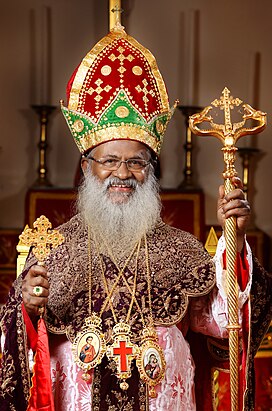
The spiritual head of the church is the Catholicos of the East, and its temporal head is theMalankara Metropolitan.Since 1934, both titles have been vested in one person; the official title of the head of the church is "The Catholicos of the Apostolic Throne of Saint Thomas and The Malankara Metropolitan". Baselios Marthoma Mathews III was enthroned as the Malankara Metropolitan and the Catholicos of the East. He is the eighthCatholicose of the Eastin Malankara and the 21stMalankara Metropolitan.
Oriental Orthodox Churches,including the Malankara Orthodox Syrian Church, accept only the first threeecumenical councils:theFirst Council of Nicaea,theFirst Council of Constantinople,and theCouncil of Ephesus.The church, like all other Oriental Orthodox Churches, uses the originalNicene Creed[39]without thefilioque clause.[40]Like theSyriac Orthodox Church,it primarily uses theliturgy of Saint JamesinMalayalam,Konkani,Kannada,Hindi,Englishand other Indian languages.
Liturgy and canonical hours

The church has used theMalankara Rite,part of theAntiochene Rite,since the 17th century.[41]TheJacobite Churchand theMaronite Churchalso belong to the same liturgical family. In the first half of the fifth century, the Antiochene church adopted theLiturgy of Saint James.In the 4th and 5th centuries, The liturgical language of fourth- and fifth-century Jerusalem and Antioch was Greek, and the original liturgy was composed in Greek.
After theCouncil of Chalcedonin 451, theEastern Churchwas divided in two; one group accepted the council, and the other opposed it. Both groups continued to use the Greek version of the Saint James liturgy. TheByzantine emperor Justin(518–527) expelled the opponents from Antioch, and they took refuge in the Syriac-speakingMesopotamiaon the Roman–Persian border (modern eastern Syria,Iraq,and southeastern Turkey). The Antiochene liturgical rites were gradually translated into Syriac, andSyriac hymnswere introduced.
Gregorios Abdal Jaleel came to Malankara from Jerusalem in 1665 and introduced Syriac Orthodox liturgical rites. The most striking characteristic of the Antiochene liturgy is its large number ofanaphoras(celebrations of theEucharist). About eighty are known, and about a dozen are used in India. All have been composed following the Liturgy of Saint James.[42]
Christians of the Malankara Orthodox Syrian Church pray thecanonical hoursof theShehimoatfixed prayer timesseven times a day.[43]
Theliturgy of Mor Addaiis still in use, in anaphora form, similar to the Maronite Sharar. Theanaphora of St. John Chrysostomis sometimes used.
Saints
In conformity with otherEasternandOriental Orthodox Churches,and also with theCatholic Church,the Malankara church adheres to the tradition of seeking theintercession of saints.Several have beencanonized:
- Geevarghese Gregorios of Parumala:Entombed inSt. Peter and St. Paul's Church, Parumala,and canonized by Geevarghese II in 1947
- Baselios Yeldo:Entombed inSt. Thomas Church, Kothamangalam,and canonised by Geevarghese II in 1947
- Geevarghese Dionysius of Vattasseril:Entombed in theOrthodox Theological Seminary, Kottayam,and canonized by Mathews II in 2003
- Antonio Francisco Xavier Alvares:Entombed in St. Mary's Orthodox Church, Ribandar, and declared a regional saint by Paulose II in 2015. (Not officially canonized a saint)[44]
- Fr. Roque Zephrin Noronah:Entombed in St. Mary's Orthodox Cathedral, Brahmavar, and declared a regional saint by Paulose II in 2015 (Not officially canonized a saint)[45]
-
Geevarghese Gregorios of Parumala
-
Geevarghese Dionysius of Vattasseril
-
Antonio Francisco Xavier Alvares
Malankara Metropolitan
The temporal, ecclesiastical and spiritual administration of the church is vested in theMalankara Metropolitan,subject to the church constitution[46]which was adopted in 1934. TheMalankara Metropolitanis president of theMalankara Syrian Christian Association (Malankara Association)and its managing committee, and trustee of community properties. He is the custodian of the Pazhaya Seminary and other common properties of Malankara Syrian Community. He is also the custodian of vattipanam interest which was deposited in Travancore Government by Marthoma VII. He is elected by the Malankara association.
List of Malankara Metropolitans
- Thoma I(1653–1670)[47]
- Thoma II(1670–1686)
- Thoma III(1686–1688)
- Thoma IV(1688–1728)
- Thoma V(1728–1765)
- Thoma VI(1765–1808)
- Thoma VII(1808–1809)
- Thoma VIII(1809–1816)
- Thoma IX(1816)
- Dionysius II(1816)
- Dionysius III(1817–1825)
- Dionysius IV(1825–1852)
- Mathews Athanasius(1852–1877)
- Dionysius V(1865–1909)[48]
- Dionysius VI(1909–1934)[49]
- Geevarghese II(1934–1964)[50]From 1934 Malankara Metropolitan also holds the office ofCatholicos of the Eastof the Malankara Orthodox Syrian Church.
- Augen I(1964–1975), also Catholicos of the East
- Mathews I(1975–1991), also Catholicos of the East
- Mathews II(1991–2005),[51]also Catholicos of the East
- Didymos I(2005–2010), also Catholicos of the East
- Paulose II(2010–2021), also Catholicos of the East
- Mathews III(15th Oct 2021–Present), also Catholicos of the East[52][53]
Catholicate
"Catholicos" means "the general head", and can be considered equivalent to "universal bishop."[54]The early church had three priestly ranks:episcopos(bishop), priest and deacon. By the end of the third century, bishops of important cities in theRoman Empirebecame known as metropolitans. The fourth-century ecumenical councils recognized the authority of the metropolitan. By the fifth century, the bishops of Rome, Constantinople, Alexandria and Antioch gained control of the churches in surrounding cities.[55]They gradually became the heads of the regional churches, and were known as patriarchs (common father).
Outside the Roman Empire, patriarchs were known as catholicos. There were four catholicates before the fifth century: the Catholicate of the East, the Catholicate of Armenia, the Catholicate of Georgia and the Catholicate of Albania. The archdeacons reigned from the fourth to the 16th centuries; in 1653, the archdeacon was elevated to bishop by the community as Mar Thoma I.
The Catholicate of the East was relocated to India in 1912, andBaselios Paulose Iwas seated on the apostolic throne of St. Thomas as the Catholicos of the East by the disposed Patriarch of Antioch Abdul Masih. The headquarters of the Malankara Orthodox Syrian Church and the Catholicos of the East is the Catholicate Palace at Devalokam,Kottayam,Kerala,which was consecrated on 31 December 1951. The new palace, built in 1961, was dedicated by visiting Armenian CatholicosVazgen I.
The Holy Synod and Managing committee designated H.G.Dr. Mathews Mor Severios to the new Malankara Metropolitan and Catholicos of Malankara Church succeeding Baselios Marthoma Paulose II. He was consecrated as the 22nd Malankara Metropolitan during the Malankara Association that took place on the 14th of October 2021 at St. Peter and St. Paul's Church, Parumala and enthroned as the 9th Catholicos of Malankara Church on 15 October 2021.[8][9][10].[56] Relicsof St. Thomas are kept in the catholicate chapel, andGeevarghese II,Augen I,Mathews IandPaulose IIare interred there.
List of Catholicos of the East of the Malankara Orthodox Syrian Church
The list ofCatholicos of the Eastof Malankara Church:
- Baselios Paulose I(1912–1914)
- Vacant (1914–1925)
- Baselios Geevarghese I(1925–1928)
- Baselios Geevarghese II(1929–1964)
- From 1934 Catholicos is also holding the office ofMalankara Metropolitan.
- Baselios Augen I(1964–1975)
- Baselios Mar Thoma Mathews I(1975–1991)
- Baselios Mar Thoma Mathews II(1991–2005)
- Baselios Mar Thoma Didymos I(2005–2010)
- Baselios Mar Thoma Paulose II(2010–2021)
- Baselios Mar Thoma Mathews III(2021–present)
Administration
Until the 17th century, the church was administered by the archdeacon (Malankara Moopan).[57]The elected archdeacon was in charge of day-to-day affairs, including the ordination of deacons to the priesthood. Ordinations were performed by Persian bishops visiting India. The Malankara Palliyogam (a forerunner of the Malankara Association) consisted of elected representatives from individual parishes. The isolation of the Malankara church from the rest ofChristendompreserved the apostolic age's democratic nature through interactions with Portuguese (Roman Catholic) and British (Anglican) colonialists. From the 17th to the 20th centuries, the church had five pillars of administration:
- The Episcopal Synod, presided over by the Catholicos of the East
- The Malankara Association, presided byMalankara Metropolitan
- Three trustees: the Malankara metropolitan andpriestand lay trustees
- The Malankara Association's managing and working committees[58][59]
1934 church constitution
Envisioned by Dionysius VI, the church's general and day-to-day administration was codified in its 1934 constitution. The constitution[60]was presented at the 26 December 1934 Malankara Christian Association meeting at M. D. Seminary,[61]adopted and enacted. It has been amended three times. Although the constitution was challenged in court by dissident supporters of thePatriarch of Antioch,Supreme Courtrulings in 1958, 1995, 2017 and 2018 upheld its validity.[62]
The constitution's first article asserts the relationship between theSyriac Orthodox Churchand the Malankara Church. The second article addresses the establishment of the Malankara Church by St. Thomas and ascribes primacy to theCatholicos.The third article regards the church's name. The fourth article describes the faith and its traditions. The fifth article examines church governancecanon law.[63]
Malankara Association
The elected Malankara Association, consisting of parish members, manages the church's religious and social concerns. Formerly the Malankara Palli-yogam (മലങ്കര പള്ളി യോഗം; Malankara Parish Assembly, its modern form is believed to have been founded in 1873 as the Mulanthuruthy Synod, a gathering of parish representatives inParumala.In 1876, the Malankara Association began.[64]
The church constitution outlines the association's powers and responsibilities. TheCatholicos of the East and Malankara Metropolitanis the president, and the diocesanmetropolitan bishopsare vice-presidents. All positions are elected. Each parish is represented in the association by an elected priest and laypeople, proportional to parish-membership size.
Co-Trustees Elected By Malankara Association
This is a list of Co-Trustees (Priest Trustee& Lay Trustee) elected by the Malankara Association[65][66]of the Malankara Orthodox Syrian Church:
| Year of Election | Clergy Trustee | Duration | Lay Trustee | Duration |
|---|---|---|---|---|
| 1869 | Punnathra Chacko Chandapilla Kathanar | 21 Oct 1869 - 13 Sep 1886 | Kulangara Ittychan Pailey | 12 Oct 1869 —? |
| 1886 | Konat Kora Yohannan Kathanar | 13 Sep 1886 - 09 Mar 1890 | Kunnumpurath Kora Ulahannan, Kottayam | 13 Sep 1886 & 31 Mar 1892 - 24 Feb 1901 |
| 1892 | Konat Kora Mathan Malpan | 31 Mar 1892 & 23 Nov 1895 - 07 Sep 1911 |
- | |
| 1901 | - | C. J. Kurien (Kunnumpurath Ulahannan Kora), Kottayam | 25 Apr 1901 - 07 Sep 1911 | |
| 1911 | Palappalil Mani Paulose Kathanar Pampakuda | 07 Sep 1911 - 21 Dec 1955 | Chirakadavil Kora Kochu Korula, Kottayam (d. 1931) | 07 Sep 1911 - 31 May 1931 |
| 1931 | - | E. I Joseph, Kottayam | 10 Jul 1931 - 15 Jul 1946 | |
| 1958 | Manalil Jacob Kathanar | 26 dec 1958 - 28 Dec 1965 | Ooppoottil Kurien Abraham, Kottayam | 26 Dec 1958 - 12 Dec 1978 |
| 1965 | Thengumthottathil T. S. Abraham Cor Episcopa | 28 Dec 1965 - 28 Dec 1982 | - | |
| 1980 | - | Padinjarekkara P. C. Abraham, Kottayam | 01 May 1980 - 21 Mar 2007 | |
| 1982 | Konat Abraham Malpan | 28 Dec 1982 - 03 Mar 1987 | - | |
| 1987 | Fr. Mathai Nooranal | 29 Dec 1987 - 29 Nov 2002 | - | |
| 2004 | Fr. Dr. O. Thomas | 10 Jun 2004 - 21 Mar 2007 | - | |
| 2007 | Fr. Johns Abraham Konat | 21 Mar 2007 - 07 Mar 2012 | M.G. George Muthoot | 21 Mar 2007 - 07 Mar 2012 |
| 2012 | Fr. Johns Abraham Konat | 07 Mar 2012 - 01 Mar 2017 | M.G. George Muthoot | 07 Mar 2012 - 01 Mar 2017 |
| 2017 | Fr. Dr. M.O. John | 01 Mar 2017 - 04 Aug 2022 | George Paul (d. 2019) | 01 Mar 2017 - 26 Nov 2019 |
| 2022 | Fr. Dr. Thomas Varghese Amayil | 04 Aug 2022 - Present | Ronny Varghese Abraham | 04 Aug 2022 - Present |
Dioceses
- Thiruvananthapuram Diocese
- Kollam Diocese
- Kottarakkara Punaloor Diocese
- Adoor Kadampanad Diocese
- Thumpamon Diocese
- Nilakal Diocese
- Mavelikara Diocese
- Chengannur Diocese
- Niranam Diocese
- Kottayam Diocese
- Kottayam Central Diocese
- Idukki Diocese
- Kandanad West Diocese
- Kandanad East Diocese
- Kochi Diocese
- Angamaly Diocese
- Thrissur Diocese
- Kunnamkulam Diocese
- Malabar Diocese
- Sulthan Bathery Diocese
- Brahmavar Diocese
- Bangalore Diocese
- Madras Diocese
- Bombay Diocese
- Ahmedabad Diocese
- Delhi Diocese
- Calcutta Diocese
- UK, Europe and Africa Diocese
- Northeast America Diocese
- Southwest America Diocese[67]
Metropolitan Bishops
The church's Episcopal Synod has the following diocesan bishops:[68][69]
- Baselios Marthoma Mathews IIICatholicos of the East and Malankara Metropolitan.Kandanad West,Bangalore DioceseandKottayam Central
- Thomas Mar Athanasios– Metropolitan ofKandanad East Diocese
- Yuhanon Mar Meletius– Metropolitan ofThrissur Diocese
- Kuriakose Mar ClemisValiya Metropolita[70]– Retired
- Geevarghese Mar Coorilose– Metropolitan ofBombay Diocese
- Zachariah Mar Nicholovos– Metropolitan ofNortheast America Diocese
- Yakob Mar Irenios– Metropolitan ofKochi Diocese
- Gabriel Mar Gregorios-Metropolitan ofTrivandrum Diocese
- Yuhanon Mar Chrysostamos– Metropolitan ofNiranam Diocese
- Yuhanon Mar Policarpos– Metropolitan ofAnkamali Diocese
- Mathews Mar Theodosius- On Leave
- Joseph Mar Dionysius– Metropolitan ofKollam Diocese
- Abraham Mar Ephiphanios– Metropolitan ofMavelikara Diocese
- Mathews Mar Thimothios– Metropolitan ofChengannur Diocese
- Alexios Mar Eusebios- Metropolitan ofCalcutta Diocese
- Yuhanon Mar Dioscoros– Metropolitan ofKottayam Diocese
- Youhanon Mar Demetrios– Metropolitan ofDelhi Diocese
- Yuhanon Mar Thevodoros– Metropolitan ofKottarakara–Punalur Diocese
- Yakob Mar Elias– Metropolitan ofBrahmavar Diocese
- Joshua Mar Nicodemos– Metropolitan ofNilackal Diocese
- Zacharias Mar Aprem– Metropolitan ofAdoor–Kadampanadu Diocese
- Geevarghese Mar Yulios– Metropolitan ofKunnamkulam Diocese
- Abraham Mar Seraphim– Metropolitan ofThumbamon Diocese[71]
- Abraham Mar Stephanos-Metropolitan ofUK, Europe, Africa Diocese
- Thomas Mar Ivanios- Metropolitan ofSouthwest America Diocese
- Geevarghese Mar Theophilos- Metropolitan ofAhmedabad Diocese& Asst. Metropolitan ofBombay Diocese
- Geevarghese Mar Philexinos- Metropolitan ofMadras Diocese& Asst. Metropolitan ofBangalore Diocese[72]
- Geevarghese Mar Pachomios- Metropolitan ofMalabar Diocese
- Geevarghese Mar Barnabas- Metropolitan ofSulthan Bathery Diocese
- Zachariah Mar Severios- Metropolitan ofIdukki Diocese
Churches with historical importance
- St. Peter and St. Paul's Church, Parumala
- St. George's Church, Chandanapally
- St. Mary's Orthodox Cathedral, Arthat
- St. Mary's Church, Thiruvithamcode,established by Apostle Saint Thomas
- St. Mary's Church, Niranam,established by Apostle Saint Thomas
- St. Mary’s Orthodox Cathedral, Puthencavu
- Mar Beshanania Orthodox Church, Vanchithra, Kozhencherry
- St. Mary's Orthodox Cathedral, Pazhanji
- St. Mary's Church, Kottayam
- KalladaValiyapally
- KundaraValiyapally
- St. Thomas Orthodox Syrian Cathedral, Mulanthuruthy
- Thumpamon Valiya Pally
- Ambalam Pally, Kunnamkulam
- ThevalakkaraChurch
- Kottakkakathu Old Syrian Church, Karthikappally
- Puthuppally Pally
- St. Mary's Orthodox Cathedral, Kandanad
- St. George Orthodox Valiyapally, Mylapra
- St. Thomas Orthodox Cathedral, Kadampanad
- St. Peter and St. Paul's Church, Kolenchery
- St. George Orthodox Church, Cheppad
- St. Mary's Orthodox Syrian Cathedral, Piravom
- St. George's Church, Kadamattom
- St Mary's Orthodox Church, Kallooppara
- St. George's Church, Chandanapally
- St. Mary’s Orthodox Cathedral, Puthiyacavu Mavelikara
- Old Syrian Church, Chengannur
- St. Stephen's Orthodox Cathedral, Kudassanad
- Kadeesa Orthodox Cathedral, Kayamkulam
Monasteries and convents
Spiritual organizations
The church has a number of spiritual organizations:
- Orthodox Syrian Sunday School Association of the East (OSSAE)[73]
- Orthodox Christian Youth Movement (OCYM)
- Mar Gregorios Orthodox Christian Student Movement(MGOCSM)[74]
- Divyabodhanam (Theological Education Programme for the Laity)
- St. Paul's & St.Thomas Suvishesha Sangam (National Association for Mission Studies)
- Orthodox Sabha Gayaka Sangham
- Malankara Orthodox Baskiyoma Association
- Servants of the Cross
- Akhila Malankara Prayer Group Association
- Akhila Malankara Orthodox Shusrushaka Sangham (AMOSS)
- Mission Board and Mission Society
- Ministry of Human Empowerment
- Akhila Malankara Balasamajam
- St. Thomas Orthodox Vaidika Sanghom
- Marth Mariam Vanitha Samajam (women's wing)
- Ecological Commission
- Ardra Charitable Trust[75]
Seminaries
The two seminaries which offers bachelor's and master's degrees in theology areOrthodox Theological Seminary, Kottayam[76]andSt. Thomas Orthodox Theological Seminary, Nagpur.[77] The Malankara Orthodox Seminary at Kottayam is the first Orthodox Seminary in Asia established in year 1815.
Ecumenical relations
The church was a founding member of theWorld Council of Churches.[78]Catholicos Geevarghese II and other metropolitan participated in the 1937 Conference on Faith and Order inEdinburgh;a church delegation participated in the 1948 WCC meeting inAmsterdamin 1948, and the church played a role in the 1961 WCC conference inNew Delhi.MetropolitanPaulos Gregorioswas president of the WCC from 1983 to 1991.
The church participated in the 1965 Conference of Oriental Orthodox Churches inAddis Ababa.[79]It is a member of theFaith and Order Commission,theChristian Conference of Asia and the Global Christian Forum. A number of primates of sister churches have visited, includingPatriarch Justinian of Romaniain February 1957 and in January 1969;Catholicos of All ArmeniansVazgen Iin December 1963; Armenian PatriarchDerderianof Jerusalem in December 1972;Patriarch Pimen I of Moscowin January 1977;Catholicos-Patriarch of All GeorgiaIlia IIin September 1982; Archbishop of CanterburyRobert Runciein 1986, PatriarchTeoctist Arăpașuof Romania in 1989;Ecumenical Patriarch of ConstantinopleBartholomew Iin November 2000; Metropolitan (later Patriarch)Kirillof theRussian Orthodox Churchin December 2006;Catholicos of All ArmeniansKarekin IIin November 2008,Patriarch of EthiopiaAbune Paulosin December 2008; theArmenian Catholicos of CiliciaAram I Keshishianin February 2010, andPatriarch of EthiopiaAbune Mathiasin November 2016.
Order of St. Thomas
TheOrder of St. Thomas,the church's highest award is presented to heads of state and churches by theCatholicos of the East and Malankara Metropolitan.Recipients includeBartholomew I of Constantinople,Patriarch and Catholicos of All ArmeniansKarekin II,Patriarch of EthiopiaAbune Paulos,Armenian Catholicos of CiliciaAram I,and Patriarch of EthiopiaAbune Mathias.[80]
See also
References
- ^"St. Vattasseril Geevarghese Mar Dionysios".Pilning,Bristol:St. Mary's Indian Orthodox.Retrieved5 May2022.
- ^abAttwater, Donald(1937).The Dissident Eastern Churches.Milwaukee:Bruce Publishing Company.
- ^abcBrock, Sebastian P.(2018). "Thomas Christians". In Mardutho, Beth (ed.).Gorgias Encyclopedic Dictionary of the Syriac Heritage: Electronic Edition.Gorgias Press.Retrieved9 July2022.
- ^Lossky, Nicholas; Bonino, José Miguez; Pobee, John, eds. (1991). "Oriental Orthodox Churches".Dictionary of the Ecumenical Movement.Geneva:World Council of Churches.p. 756-757.
- ^ab"The Malankara Orthodox Syrian Church".Catholic Near East Welfare Association.Retrieved9 July2022.
- ^abAttwater, Donald(1935). "The Malankarese".The Catholic Eastern Churches(1937 revised ed.).Milwaukee:Bruce Publishing Company.
- ^Zachariah, K.C. (April 2016)."Religious denominations of Kerala"(PDF).Kerala: Centre for Development Studies (CDS). Working paper 468. Archived fromthe original(PDF)on 11 June 2022.
- ^Thomas Arthur Russell (2010).Comparative Christianity: A Student's Guide to a Religion and Its Diverse Traditions.Universal-Publishers. p. 40.ISBN978-1-59942-877-2.
The Malankara Orthodox Church of India(also called by a variety of names, such as the Malankara Church). It is located in Kerala, India.
- ^"Home".Northeast American Diocese of the Malankara Orthodox Syrian Church.Retrieved20 June2022.
- ^John; Anthony McGuckin (November 2010).The Encyclopedia Of Eastern Orthodox Christianity, 2 Volume Set.West Sussex: Wiley-Blackwells. p. 878.ISBN978-1-4443-9254-8.
The Malankara Orthodox Syrian Church, also known asIndian Orthodox ChurchalsoMalankara Church,is one of the major and oldest churches in the world.
- ^Lucian N. Leustean (2010).Eastern Christianity and the Cold War, 1945–91.New York: Routeledge Taylor & Francis Group. p. 317.ISBN978-0-203-86594-1.
- ^Fahlbusch; Lochman; Mbiti; Pelikan (November 2010).The Encyclopedia Of Christianity, Volume 5 S-Z.Gittingen, Germany: Vandenhoeck&Rupercht. p. 285.ISBN978-0-8028-2417-2.
The autocephalous Malankara Orthodox Church is governed by Holy Episcopal Synod of 24 Bishops presided over by His Holiness Moran Mar Baselios Mar Thoma Didimos Catholicos of the East and Malankara Metropolitan.
- ^The Encyclopedia of Christianity, Volume 5by Erwin Fahlbusch. Wm. B. Eerdmans Publishing – 2008. p. 285.ISBN978-0-8028-2417-2.
- ^Malankara Orthodox Syrian Church.The Constitution of the Malankara Orthodox Syrian Church in English.
- ^FP Staff (27 September 2019)."Malankara church row: All you need to know about century-old dispute between Jacobite, Orthodox factions in Kerala".FirstPost.Retrieved27 April2020.
- ^Winkler 1997,p. 33-40.
- ^Brock 2016,p. 45–52.
- ^The Blackwell Companion to Eastern Christianityby Ken Parry 2009ISBN1-4443-3361-5page 88[1]
- ^"Catholic Encyclopedia: Henoticon".Newadvent.org. 1 June 1910.Retrieved30 June2013.
- ^Varghese, Baby(2011)."Malankara Orthodox Syrian Church".In Sebastian P. Brock; Aaron M. Butts; George A. Kiraz; Lucas Van Rompay (eds.).Gorgias Encyclopedic Dictionary of the Syriac Heritage: Electronic Edition.Gorgias Press.Retrieved22 September2016.
- ^"The Malankara Orthodox Syrian Church".Malankara Orthodox Syrian Church.Retrieved31 May2022.
- ^Baby Varghese (2010). "Renewal in the Malankara Orthodox Church, India".Studies in World Christianity.16(3).Edinburgh University Press:226–244.doi:10.3366/swc.2010.0102.ISSN1354-9901.
- ^"St. Thomas Christians".Catholic Encyclopedia.Archivedfrom the original on 25 January 2020.Retrieved11 March2020– viaNew Advent.
- ^Brock, Sebastian P."Thomas Christians".eGEDSH.
- ^Frykenberg 2008,p. 93;Wilmshurst 2000,p. 343.
- ^Brown 1956,p. 100.
- ^Baum & Winkler 2003,p. 115-116.
- ^Neill 2004,p. 316.
- ^Vadakkekara 2007,pp. 84, 86;Frykenberg 2008,p. 361.
- ^"Synod of Diamper." Encyclopedia Britannica. Encyclopedia Britannica Online. Encyclopedia Britannica Inc., 2011. Web. 23 December 2011.
- ^For the Acts and Decrees of the Synod cf. Michael Geddes, "A Short History of the Church of Malabar Together with the Synod of Diamper &c." London, 1694;Repr. in George Menachery, Ed., Indian Church History Classics, Vol.1, Ollur 1998, pp.33-112
- ^Thekkedath, History of Christianity in India "
- ^Eugene Cardinal Tisserant, "Eastern Christianity in India"
- ^"A feud that began in 19th century: What happened before Jacobite-Orthodox locked horns".6 February 2019.
- ^"From 1599 to today: Tracing Kerala's Jacobite vs Orthodox church battle".8 August 2017.
- ^"About the church".Niranam St. Mary's Orthodox Syrian Church. 2009. Archived fromthe originalon 27 January 2010.Retrieved25 April2010.
- ^"Centenary celebrations of Malankara Orthodox Syrian Church begin | Kochi News - Times of India".The Times of India.3 November 2011.
- ^"Kerala church split".scroll.in.
- ^Geevarghese Mar Yulios: Ecumenical Council of Nicea and Nicene Creed
- ^Paulos Mar Gregorios: Oriental and Eastern Orthodox churches
- ^"Liturgy Holy Qurbana St. Thomas Indian Orthodox Church".indianorthodoxireland.ie.13 May 2016.Retrieved6 November2019.
- ^"Malankara Orthodox Church – Holy Qurbana".Malankaraorthodoxchurch.in.Archivedfrom the original on 30 April 2013.Retrieved23 October2012.
- ^Kurian, Jake.""Seven Times a Day I Praise You" – The Shehimo Prayers ".Diocese of South-West America of the Malankara Orthodox Syrian Church.Retrieved2 August2020.
- ^Philip, Dr. Ajesh T.; Alexander, George (May 2018).The Mission Untold.Western Rites of Syriac-Malankara Orthodox Churches. Vol. I. India: OCP Publications, Alappuzha. p. 17.ISBN978-1-387-80316-3.
- ^Philip, Dr. Ajesh T.; Alexander, George (May 2018).The Mission Untold.Western Rites of Syriac-Malankara Orthodox Churches. Vol. I. India: OCP Publications, Alappuzha. p. 83.ISBN978-1-387-80316-3.
- ^"1934 constitution of The Malankara Church (മലങ്കരസഭ ഭരണഘടന)".Archived fromthe originalon 2 May 2018.Retrieved29 February2020.
- ^"Coonan Cross Oath History".Archived fromthe originalon 24 February 2021.Retrieved29 February2020.
- ^"Royal Court Verdict declared Pulikottil Joseph Dionysius as the rightful Malankara Metropolitan".
- ^"In 1929, Travancore High Court declared Dionysius of Vattasseril will remain as the Malankara Metropolitan (Vattipanam Suit)".
- ^"In 1958, Supreme Court of India declared Baselios Geevarghese II is the rightful Malankara Metropolitan (Samudayam Suit)".
- ^"Supreme Court Order July 12, 2002 declared Baselios Mar Thoma Mathews II is the unquestionable Malankara Metropolitan of the Malankara Church".
- ^"Supreme head of the Malankara Orthodox Syrian Church passes away".The Hindu.12 July 2021.
- ^"Ordination of the new Malankara Metropolitan & Catholicos. H.H Moran Baselios Marthoma Paulose 2 is the present Malankara Metropolitan.Baselios Marthoma Paulose 2 is the 21st Malankara Metropolitan".November 2010.
- ^"The Catholicate of the Malankara Orthodox Syrian Church".Malankara Syrian Orthodox Church.Retrieved12 March2020.
- ^"The Catholicate of the Malankara orthodox Syrian Church |".mosc.in.Retrieved14 January2024.
- ^"Catholicos of the East | our-church".stthomasorthodoxcathedral.Archived fromthe originalon 4 August 2020.Retrieved6 November2019.
- ^Niranam Granthavari (Record of History written during 1770–1830). Editor Paul Manalil, M.O.C.Publications, Catholicate Aramana, Kottayam. 2002.
- ^"The Managing Committee".mosc.in.
- ^"The Working Committee".mosc.in.
- ^"Malankara Orthodox Syrian Church Constitution"(PDF).1934.
The Malankara Church is a division of the Orthodox Syrian Church. The Primate of the Orthodox Syrian Church is the Patriarch of Antioch.
- ^"The Constitution of the Malankara Orthodox Church".mosc.in.
- ^Rajagopal, Krishnadas (16 November 2017)."SC says no review of Malankara Church verdict: Upholds 1934 constitution of Church".The Hindu.
- ^"The Constitution of the Malankara Orthodox Church".Malankara Orthodox Syrian Church.Retrieved14 September2023.
- ^"Malankara Association".malankaraorthodoxchurch.in.Archivedfrom the original on 25 April 2013.Retrieved22 October2012.
- ^"Malankara Association".mosc.in.Retrieved15 April2023.
- ^"Malankara Association".ovsonline.in.Retrieved15 April2023.
- ^"Dioceses".mosc.in.Malankara Orthodox Syrian Church.Archivedfrom the original on 16 January 2018.Retrieved10 April2018.
- ^"Holy Synod".mosc.in.2019.
- ^"Kalpana No. 344/2022 Appointments of Bishops"(PDF).mosc.in.Retrieved27 September2023.
- ^"Kalpana No. 248 – H G Mar Cleemis Valiya Metropolita"(PDF).mosc.in.Retrieved26 September2023.
- ^"Kalpana No. 240 – Thumpamon Diocese Mar Seraphim Metropolitan"(PDF).mosc.in.Retrieved27 September2023.
- ^"Kalpana No. 242 – Bangalore Diocese Mar Philaxenos Metropolitan"(PDF).mosc.in.Retrieved27 September2023.
- ^"OSSAE website".ossae.org.
- ^"MGOCSMwebsite".mgocsm.in/index.php.
- ^"Spiritual Organisation".mosc.in.Malankara Orthodox Syrian Church.
- ^"Orthodox Theological Seminary Kottayam".Retrieved13 March2020.
- ^"St. Thomas Orthodox Theological Seminary {STOTS), Nagpur".Retrieved13 March2020.
- ^"World council of churches, Amsterdam 1948".archive.org.1948. p. 230.
- ^"Addis Ababa Conference".theorthodoxchurch.info.
- ^"Recipients of the order of St. Thomas".Malankaraorthodox.tv.Retrieved1 August2018.
Bibliography
- Baum, Wilhelm;Winkler, Dietmar W. (2003).The Church of the East: A Concise History.London-New York: Routledge-Curzon.ISBN9781134430192.
- Brock, Sebastian P.(2016)."Miaphysite, not Monophysite!".Cristianesimo Nella Storia.37(1): 45–52.ISBN9788815261687.
- Brown, Leslie W. (1956).The Indian Christians of St Thomas: An Account of the Ancient Syrian Church of Malabar.Cambridge: Cambridge University Press.
- Fahlbusch, Erwin Fahlbusch, Geoffrey William Bromiley (198),The Encyclopedia of Christianity,Wm. B. Eerdmans Publishing, 2008,ISBN978-0-8028-2417-2
{{citation}}:CS1 maint: multiple names: authors list (link) - Frykenberg, Robert E. (2008).Christianity in India: From Beginnings to the Present.Oxford: Oxford University Press.ISBN978-0-19-826377-7.
- Joseph Cheeran, et al.(2002) Tradition and History of Indian Orthodox Church, p. 300–423
- Menachery, George (1973).The St. Thomas Christian Encyclopaedia of India Vol. II.
- Menachery, George (1998).The Indian Church History Classics: The Nazranies.
- Neill, Stephen(1966).Colonialism and Christian Missions.New York: McGraw-Hill.
- Neill, Stephen(2004) [1984].A History of Christianity in India: The Beginnings to AD 1707.Cambridge: Cambridge University Press.ISBN9780521548854.
- Neill, Stephen(2002) [1985].A History of Christianity in India: 1707-1858.Cambridge: Cambridge University Press.ISBN9780521893329.
- Tamcke, Martin (2009).Die Christen vom tur Abdin: Hinführung zur Syrisch-orthodoxen Kirche.Verlag Otto Lembeck. 3874765806.
- Vadakkekara, Benedict (2007).Origin of Christianity in India: A Historiographical Critique.Delhi: Media House.ISBN9788174952585.
- Van der Ploeg, J. P. M. (1983).The Christians of St. Thomas in South India and their Syriac Manuscripts.Dharmaram Publications.
- Wilmshurst, David (2000).The Ecclesiastical Organisation of the Church of the East, 1318–1913.Louvain: Peeters Publishers.ISBN9789042908765.
- Wilmshurst, David (2011).The Martyred Church: A History of the Church of the East.London: East & West Publishing Limited.ISBN9781907318047.
- Winkler, Dietmar W. (1997)."Miaphysitism: A New Term for Use in the History of Dogma and in Ecumenical Theology".The Harp.10(3): 33–40.
External links
- Official website of the Indian (Malankara) Orthodox Syrian Church
- Complete website of Catholicos of The East and Malankara Metropolitan
- Malankara Orthodox Syrian Church Constitution of 1934
- Indian Orthodox Radio | E – Radio from the Shores of Malankara to the World
- Indian Orthodox Herald: News about the Catholicate of the East
- Matha Mariam Media: A Complete Orthodox Web Portal maintained by Trivandrum Diocese
- ICON Indian Christian Orthodox Network – Catholicos of the East
- Malankara Orthodox TV
- Malankara Orthodox Syrian Church
- 1912 establishments in British India
- Oriental Orthodoxy in India
- Saint Thomas Christians
- Members of the National Council of Churches
- Members of the World Council of Churches
- Oriental Orthodox organizations established in the 20th century
- Affiliated institutions of the National Council of Churches in India




